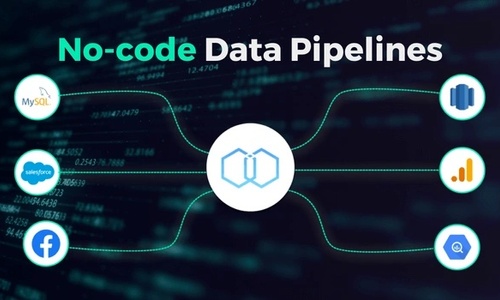Historically, connecting multiple data sources to a single destination required extensive experience as a computer programmer or data scientist. Today’s no-code data pipelines have changed that perspective. Now, practically anyone – even those without any coding experience – can use no-code pipelines to streamline data processing without damaging data quality. You will, however, need the right ETL and ELT tools to manage real-time data flows.
The following article covers these main points:
- No-code data pipelines are cloud-based features that enable users to move data from multiple sources to a destination without writing any code.
- No-code data pipelines can be used by anyone, including data engineers, marketing professionals, and sales professionals.
- Adopting a cloud-based ETL solution offers several benefits that can speed up your time-to-market, lower costs, and improve data democratization.
- Popular ETL platforms for streamlining data integration include Hevo Data, Talend, and Integrate.io.
- When choosing a no-code/low-code ETL platform, it is important to consider factors such as data security compliance, a wide range of connectors, scalability, storage options, and flexibility in data transformation
In this article, we’ll explore the advantages of no-code/low-code ETL solutions, review some popular options, and discuss tips for choosing the right solution. By embracing cloud-based ETL solutions, your organization can quickly deploy no-code data pipelines that are reliable, secure, and cost-efficient.
Let's dive in!
What Are No-Code Data Pipelines?
No-code data pipelines are features built into cloud-based software-as-a-service (SaaS) platforms designed to move data from multiple sources to at least one destination. They tend to have drag-and-drop interfaces that let users build no code ETL pipelines without writing any code.
Since parts of the ETL process (Extract, Transform, Load) often involves reformatting data before sending it to a data warehouse, pipelines include no code data transformation features that automate much of the work. Once reformatted and loaded to a central location, users can add information to business intelligence (BI) tools and other apps to discover trends hidden within the data.
It’s important to recognize the differences between low-code and no-code data pipelines. No-code data pipelines don’t require any coding knowledge from the user. Low-code pipelines give users the opportunity to customize pipelines and workflows to meet specific needs. Many ETL cloud platforms combine no-code and low-code features to give users more flexibility that matches their levels of experience and business needs.
Who Uses No-Code Data Pipelines to Streamline Data Integration?
Anyone can use no-code data pipelines to streamline data integration. The most popular SaaS platforms come with hundreds of built-in connectors that make data extraction, data migration, and data loading easy.
Even data engineers can benefit from no-code data pipelines. Let’s say you want to pull source data from advertising tools like YouTube, Snapchat Ads, and Yahoo Gemini and load reformatted data into a cloud database like Snowflake, Microsoft Azure Synapse Analytics, or AWS Redshift. A data engineer could create these pipelines manually. However, doing that would require unnecessary effort and time. They can work more efficiently by relying on an ETL platform that comes with the connectors they need.
Of course, many people using no-code data pipelines to streamline data integration don’t know how to build pipelines from scratch. For example, a marketing or sales professional might not know how to code. Still, they need to process data to gain data-driven insights that ensure the success of future campaigns.
A great no-code ETL tool will let them automatically add new data to keep up with emerging trends.
View Integrate.io’s full list of integrations to determine whether it matches your data analysis and collection needs.
Some Benefits of No-Code Data Pipelines
Some of the top benefits of adopting a data integration platform with no-code data pipelines include:
- Data democratization that breaks down silos and gives everyone better access to the information they need to do their jobs well.
- Lower development costs because companies don’t exclusively rely on data scientists. (In the U.S., the typical data scientist earns nearly $101,000 per year.)
- Faster time-to-market, making it easier for you to release products – and internal tools – that keep you ahead of competitors.
- Reliable data ingestion that can gather information from different sources for more informed decision-making.
- More opportunities to work with big data so you can add machine learning and automation to your data stack.
- Build pipelines that process large amounts of data securely and efficiently.
With cloud-based no-code data pipelines, practically anyone can perform these and other tasks. You don’t need experience as a programmer or data engineer. You just need to know how the platform works. A small amount of training puts you on the path to using complex data.
Popular ETL Platforms for Streamlining Data Integration
Clearly, no-code data pipelines can give you advantages that streamline data integration and make your organization more competitive. Some no-code ETL platforms offer more benefits than others, though. The following stand out as some of the industry’s top options.
Integrate.io
Integrate.io has become an extremely popular cloud-based no-code data pipeline tool. It has 185 reviews and a 4.3 out of 5 stars rating on G2.
Positive reviews mention features that you would expect, including Integrate.io’s:
- Easy user interface that lets anyone build efficient ETL pipelines.
- ETL components that don’t require any coding (although a little coding can help users optimize pipelines for specific use cases).
- Extremely quick job execution that moves data in real time.
- Scalability that lets users increase or decreases clusters and nodes as needed.
Other benefits you can get from Integrate.io include:
- ELT (extract, load, transform) that can reformat data after loading it to a destination.
- CDC (change data capture) that automatically replicates new information in a dataset.
- Instant REST API generation that automates documentation and creates data connections not available in the Integrate.io library.
- Company-wide data observability and credibility that monitors information and sends tailored alerts based on your needs. (Popular alert types look at null values in columns, statistical column skews, statistical column variance, and geometric means.)
- Data warehouse insights that help you understand your Redshift warehouse spend, optimize dashboard performance, optimize data price, and get custom recommendations via email or your dashboard.
Talend
Talend earns 4 out of 5 stars from 63 reviews on G2. Although not as popular as Integrate.io’s no-code data pipeline tool, users praise several of its features.
Many positive reviews mention Talend’s:
- Combination of data integration, application, and API integration, and data integrity and governance.
- Internal utility that makes it easy to implement specific warehouse methodologies without hours of coding and configuring.
- Big data extraction support that fuels everything from business analytics to machine learning.
- End-to-end cloud monitoring features.
Hevo Data
Hevo Data is an open-source, no-code bi-directional pipeline tool that supports ETL, reverse ETL, and ELT. Nearly 200 reviewers on G2 give it 4.3 out of 5 stars.
Several users mention positive features like:
- Change tracking (CT) support for SQL Server.
- A library that includes more than 100 data connectors.
- Automatic data identification that immediately uploads available information.
- Good customer support that helps non-technical users learn how to use the platform and troubleshoot problems as they arise.
- A visual interface that makes pipeline mapping easy.
What to Look for When Choosing a No-Code or Low-Code ETL Platform
There are plenty of no-code and low-code ETL platforms. Look for the following features before choosing one for your organization:
- GDPR, HIPAA, and other data security compliance.
- Large connector libraries with the tools and apps your employees use.
- Connectors that work with various data destinations, including SQL and NoSQL databases.
- Scalability that can adapt to your data teams’ evolving needs.
- Options to store data on-premises or in the cloud.
- Flexibility to transform formatted data into raw data and vice versa.
How Integrate.io Can Improve Your Data Management
Integrate.io has a lot of features that make it the most appealing option for building no-code data pipelines. In addition to its user-friendly interface, a huge library of connectors, and robust security, Integrate.io doesn’t force you to sign contracts that cause vendor lock-in. If you decide you prefer a different platform, you can always choose it over Integrate.io. Not surprisingly, that rarely happens because users get such excellent ROI.
Are you interested in learning more about how Integrate.io can help everyone on your team create no-code data pipelines that streamline data integration? Schedule a demo today to see how Integrate.io can solve your data needs!
















